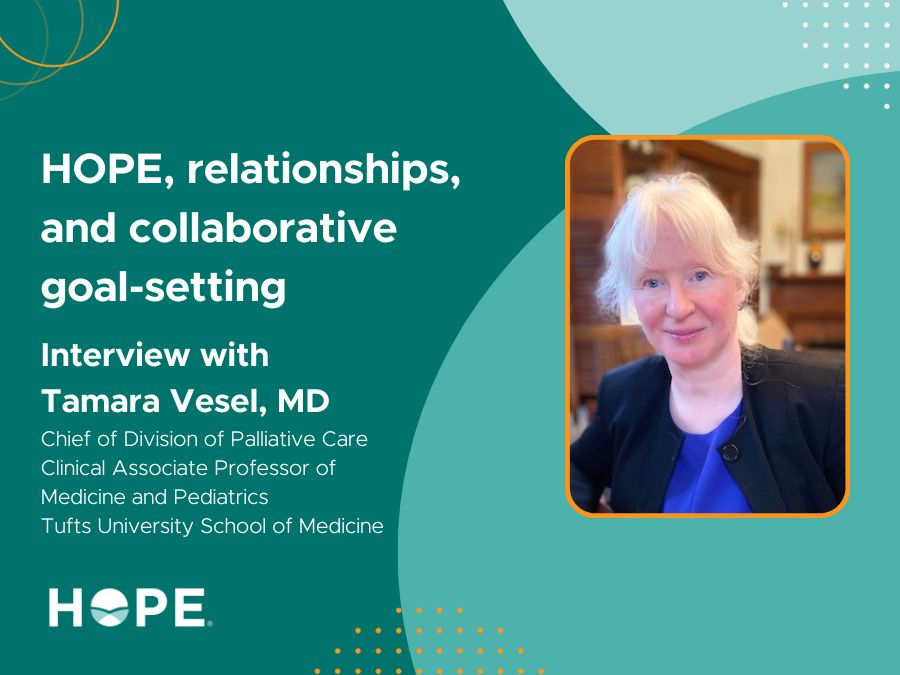
HOPE-informed care begins with identifying, honoring, and promoting child and family sources of strength and stamina. That knowledge creates the basis for working together to set and achieve the goals of care. Parents and families, of course, know about their child, their own values and beliefs, and their support systems. Providers bring a separate set of knowledge – which is why children and families seek care. In medicine, the process of recognizing and reconciling the perspectives of patients and families, and of the providers to develop treatment plans is called goal concordant care.
To find out more about goal concordant care, we sat down with Tamara Vesel, MD, Chief of Division of Palliative Care in the Department of Medicine at Tufts Medical Center. Through goal concordant care, Dr. Vesel shares stories of relationship building by finding care plans through the values of the patients and their families. The HOPE framework promotes partnership between the caregiver and the child, youth, or family. Through Dr. Vesel’s work, this partnership with families helps foster trust and honor the needs of families and patients of all ages.
Relationship building and goal concordant care
I do believe that taking care of children or taking care of the elderly has many similarities since this is all about families and their values.”
Please tell us about yourself, and how you became a pediatric palliative care physician.
I have several decades of professional experience. I started as a pediatrician and then trained in pediatric critical care. I practiced in the pediatric ICU (Intensive Care Unit) for about a decade at Tufts Medical Center, and my experience was wonderful. But I realized that taking care of critically ill children and children who may be at the end of life is much more complex than we knew at the time. I joined one of the first pediatric palliative care teams at the Boston Children’s Hospital and Dana Farber Cancer Institute where my journey continued in palliative care. I was honored to take care of children in the hospital and in their homes as well. Eventually, my professional journey led me to set up one of the first pediatric hospices in the Boston area. I took care of children and families who wanted to stay at home instead of being in the hospital long-term. Now I am back at Tufts Medical Center, where we established a Division of Palliative Care for all ages, because I do believe that patients of all ages should have an equal access to pain and palliative care during their serious illness trajectory. Taking care of children or taking care of the elderly has many similarities since this is all about families and their values.
The concept of goal concordant care began in palliative care. How does this model look in pediatric palliative care settings, and can you supply an example?
Dr. Vesel shared several examples of the use of goal concordant care throughout her palliative care career. These two stories she shares below highlight the importance of getting to know the family, patient, and understanding their values. When providers take the time to understand the needs and values of the patient and their families, they provide a safe and stable environment. This helps patients and families feel more in control of their situation.
In the neonatal ICU (Intensive Care Unit), a child was born with a very severe life-threatening genetic disease. This was a surprise to the family. When we retrieve their values, one value was having a healthy child, which was not meant to be, under those circumstances. But the second value was to minimize the suffering of any family members who have a critical illness. Based on those two important values, we did our best to allow this family to have meaningful experiences, but at the same time, concentrated on minimizing the suffering of their child. Those two values were at times conflicting but eventually they became congruent.
In the medical neuroscience ICU, we took care of a 94-year-old woman, who had a severe stroke and could not make decisions for herself. We were sitting there with her husband in his late nineties, a lovely gentleman, still in love with his wife of 69 years, and their daughter. Again, a very similar circumstance of retrieving the values that would be concordant with what the medical team was suggesting. They suggested withdrawal of life sustaining treatment. But there was conflict between the husband who clearly saw what was going on with his wife and did not want her to continue suffering, and the daughter who wanted to grasp onto the little bit of life that was still present in her mom. She had some unresolved issues in their relationship. We were able to process that over several days and eventually achieve their goal of allowing this woman, who had a very full wonderful life, to die peacefully.
The HOPE National Resource Center supports a wide range of professionals who work with children and families. Children and families are collaborators in their care, can you speak to how goal concordant care can be used in these settings? Specifically, how does the goal concordant care process support the relationship between parent and provider?
Complex question, and not easy to answer. But what comes to my mind is where I go with complex circumstances, where a child and the parents and the family need support from the healthcare team. The more complex an illness gets; the more people are involved. I always think about how to strengthen their inner strength, meaning how to get underneath the suffering, and look at where this child or the family’s strength is coming from. When you identify that, it not only strengthens the relationship between the child and the parents – or the child and grandparents, or the nuclear family itself – but also can build up a positive relationship with the caregivers. Instead of focusing on the weaknesses, problems, suffering, etc., the caregiver looks at the strength of the child that shows up and has a natural curiosity about the child’s life – how they go through mornings or just maybe a basic regular day. Teasing out those moments of strength can help providers get more engagement and support from the families and children who are experiencing illnesses.
Interview edited for brevity and clarity.


